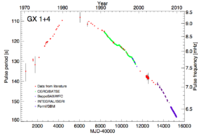GX 1+4
Also known as: V* V2116 Oph Simbad [1]
Monitoring data: CGRO/BATSE RXTE/ASM Swift/BAT MAXI Fermi/GBM pulsed flux
Coordinates
| RA | 17h 32m 02.16s | Dec | -24° 44' 44.2" |
| RA | 263.009000 | Dec | -24.745611 |
| l | 1.9370 | b | +04.7949 |
Binary system
Distance estimated between 3 and 15 kpc by [2]. [3] determine a distance of 4.3 kpc.
Orbit
| Parameter | Value | Unit | Reference |
|---|---|---|---|
| Porb | 1160.8±12.4 | days | [3] |
| Tperiastron | 2451943±53 | JD | [3] |
| a sin i | 232.2±6.0 | 106 km | [3] |
| a sin i | 776±20 | lt-sec | derived from above |
| e | 0.101±0.022 | [3] | |
| ωperiastron | 168±17 | [3] | |
| Mass function | 0.371±0.026 | Msol | [3] |
Note: In the past an orbital period of ~304 d has been assumed for this source, based on variations in the pulse period of the neutron star (see, e.g., [4]).
Optical Companion
Names: V2116Oph, 2MASS J17320215-2444442
Cool, low- to intermediate-mass, first-ascent giant or asymptotic giant branch (AGB) star ([3]).
| Parameter | Value | Unit | Reference |
|---|---|---|---|
| Mass | <1.22 | Msol | [3] |
| K | ~8 | mag | [3] |
Available data
- ASCA: 41ksec GIS exposure (Sep 1994)
- RXTE: many monitorings 1996-1997 and 2001-2002, mostly individual obs <3ksec, 1996 up to 50ksec
- Chandra: ACIS-s observations 20ksec and 57ksec (Apr and Aug 2002)
- XMM Newton: slew data only (detected as XMMSL1 J173202.0-244446 with 14cts/sec)
- BeppoSAX: ~210ksec awarded in AO1 and AO4
- INTEGRAL: frequent monitoring as part of Galactic Centre observations
- Swift: 55ksec XRT exposure (Feb 2006)
- Suzaku: 100ksec observation Okt 2010?
Description
GX 1+4 is the prototype of the small but growing subclass of accreting X-ray pulsars called Symbiotic X-ray Binaries (SyXB), by analogy with symbiotic stars, in which a white dwarf accretes from the wind of a M-type giant companion.
The system was discovered in 1970 by a balloon X-ray observation at energies above 15 keV showing pulsations with a period of about two minutes ([1]). In the following years it was one of the brightest X-ray sources in the Galactic centre region during the 1970's, spinning up strongly.
Following an extended low state in the early 1980’s it has been generally spinning down strongly, increasing its pulse period by ~50% over the last 30 years ([5]).
Currently, there is no well established value of the magnetic field of GX 1+4. Assuming standard accretion disk theory (e.g., [6], [7]), the magnetic field has been estimated to be B ∼1013 − 1014 G by different authors (e.g., [8], [9], [10]), which would be among the largest measured for any accreting X-ray pulsar. On the other hand, [11] and [12] find weak evidence for possible CRSFs in in the X-ray spectra which would point to a value of B ∼1012 G for the magnetic field, i.e., 1-2 orders of magnitude lower.
Flux
GX 1+4 is a persistent source, but with strong, irregular flux variations on various timescales (Swift/BAT lightcurve).
Spectrum
The observed spectrum of GX 1+4 can be described by a typical accreting X-ray pulsar spectrum, i.e., a cut-off power law or a comptonization model, always showing also strong intrinsic absorption and an iron line. But it is one of the hardest spectra found among all X-ray binary pulsars. Using the correlation between magnetic field strength and spectral hardness observed in various sources (e.g., [13]) this would indicate a magnetic field in excess of 1013 G.
Pulse Profile
At first approximation the pulse profiles for GX 1+4 display a single broad peak at all energies (see, e.g., [14]). The detailed shape is variable and frequently displays substructure indicative of a superposition of two peaks (see, e.g., [12]).
References
- ↑ 1.0 1.1 Cite error: Invalid
<ref>tag; no text was provided for refs namedLewin71 - ↑ Cite error: Invalid
<ref>tag; no text was provided for refs namedChakrabartyRoche97 - ↑ 3.0 3.1 3.2 3.3 3.4 3.5 3.6 3.7 3.8 3.9 Cite error: Invalid
<ref>tag; no text was provided for refs namedHinkle06 - ↑ Cite error: Invalid
<ref>tag; no text was provided for refs namedPereira99 - ↑ Cite error: Invalid
<ref>tag; no text was provided for refs namedGonzalezGalan12 - ↑ Cite error: Invalid
<ref>tag; no text was provided for refs namedGhoshLamb79a - ↑ Cite error: Invalid
<ref>tag; no text was provided for refs namedGhoshLamb79b - ↑ Cite error: Invalid
<ref>tag; no text was provided for refs namedDotani89 - ↑ Cite error: Invalid
<ref>tag; no text was provided for refs namedMony91 - ↑ Cite error: Invalid
<ref>tag; no text was provided for refs namedCuiSmith04 - ↑ Cite error: Invalid
<ref>tag; no text was provided for refs namedRea05 - ↑ 12.0 12.1 Cite error: Invalid
<ref>tag; no text was provided for refs namedFerrigno07 - ↑ Cite error: Invalid
<ref>tag; no text was provided for refs namedCoburn02 - ↑ Cite error: Invalid
<ref>tag; no text was provided for refs namedNaik05
